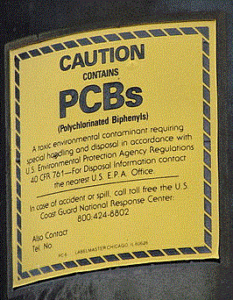Credit to althealthworks.com – Nick Meyer – January 11, 2018 –
 The state of Oregon is seeking $100 million in order to clean up the Portland Harbor and other areas affected by polychlorinated biphenyl (PCB). PCBs were used widely in electrical equipment like capacitors and transformers. Used in manufacturing, metal recycling, fuel storage, railways and other industrial uses. The pollutant is in wire coating, caulk and sealants used at the Port in Portland.
The state of Oregon is seeking $100 million in order to clean up the Portland Harbor and other areas affected by polychlorinated biphenyl (PCB). PCBs were used widely in electrical equipment like capacitors and transformers. Used in manufacturing, metal recycling, fuel storage, railways and other industrial uses. The pollutant is in wire coating, caulk and sealants used at the Port in Portland.
The lawsuit is alleging that Monsanto hid the toxic effects of its products for multiple decades, causing widespread damage to animals, plants, humans and the environment. Monsanto knew in 1937 that the product was toxic, but didn’t stop making it until 1977.
40 years later, Oregon is looking for additional means of cleaning up the messes in the Columbia and Willamette rivers even though they were already declared a government “superfund” site in 2000.
The report said that PCBs are being measured in the bodies of fish and in river sediments across the state, and that more money is needed in order to support the cleanup.
But first, let’s list some of their other notable accomplishments resulting in harm to humans and the environment.
Agent Orange used during the Viet Nam war and most of those exposed have died or are seriously ill from exposure to “dioxin.” 390 vets a day are dying with hundreds of thousands already dead due to everything from heart disease, cancer, diabetes, neurological diseases and more.
White Phosphorus – is used industrially to manufacture chemicals used in fertilizers, food additives, and cleaning compounds and it’s toxic. It is used by the military in various types of ammunition as an incendiary agent (because it spontaneously catches fire in air) and as a smoke agent (because it produces clouds of irritating white smoke). Its extremely poisonous and exposure can be fatal.
Round-Up (containing glyphosate) – the miracle weed cleaning products that was touted as biodegradable during the 70’s. In the October 24, 2017 issue of JAMA tracked people over the age of 50 in southern California from 1993-1996 to 2014-2016, with researchers periodically collecting urine samples during that time. University of California San Diego, found that the percentage of people who tested positive for a chemical called glyphosate, which is the active ingredient in the herbicide Roundup, shot up by 500% in that time period. The levels of glyphosate also spiked by 1208% during that time.
Glyphosate is also credited with honeybees starving because it leads to the decreased ability to smell and poor memory. Bees exposed to glyphosate tend to exhibit higher frequencies of Colony Collapse Disorder most likely because they cannot remember how to get back to their hive.
GMO’s – genetically modified organisms – crops currently include soybeans, corn, sugarbeets, cotton, potato, papaya, squash, canola, alfalfa and apple – 10 crops in the US. Being a GMO allows it to resist herbicides and pests. That means that it is Round-Up ready and farmers are free to spray throughout the growing season. On the plus side, it reduces the need for tilling and reduces soil erosion. On the down side, glyphosate is entering the stream that feeds animals that humans consume.
Several California west coast towns (Oakland, Berkeley, San Jose, Long Beach and San Diego) have also sued Monsanto over PCB pollution.
Oregon’s lawsuit seeks damages for public nuisance, unjust enrichment and cites trespassing — saying the contamination hurt the state’s natural resources.
Bottomline; PCB’s accumulate in the fatty tissue of fish and when ingested by humans, that contamination is passed on. According to the lawsuit, toxic effects can seriously impair the endocrine, neurologic, and reproductive systems.
It’s another example of not being able to trust our Environmental Protection Agency because oftentimes they outlaw a product far too late. A case of inadequate testing.
That’s why municipalities like ours would be wise to write up ordinances now before the damage is done. A good start would be to research the damage GMO’s could be causing and eliminate the threat before it comes to our town.
Monsanto oft-voted “Most Evil Company in the World” contestant.
Other things to be concerned about. The Monsanto-Bayer merger and other comparable companies like DuPont and Syngenta, Dow Chemical and Evogene, Ltd.
Lastly, in May 2016, Monsanto lost a lawsuit in St. Louis when the jury awarded three plaintiffs a total of $46.5 million in damages in a lawsuit alleging that Monsanto and three other companies were negligent in its handling of PCB’s. To read the entire article go to: https://www.ecowatch.com/monsanto-ordered-to-pay-46-5-million-in-pcb-lawsuit-in-rare-win-for-pl-1891143419.html


